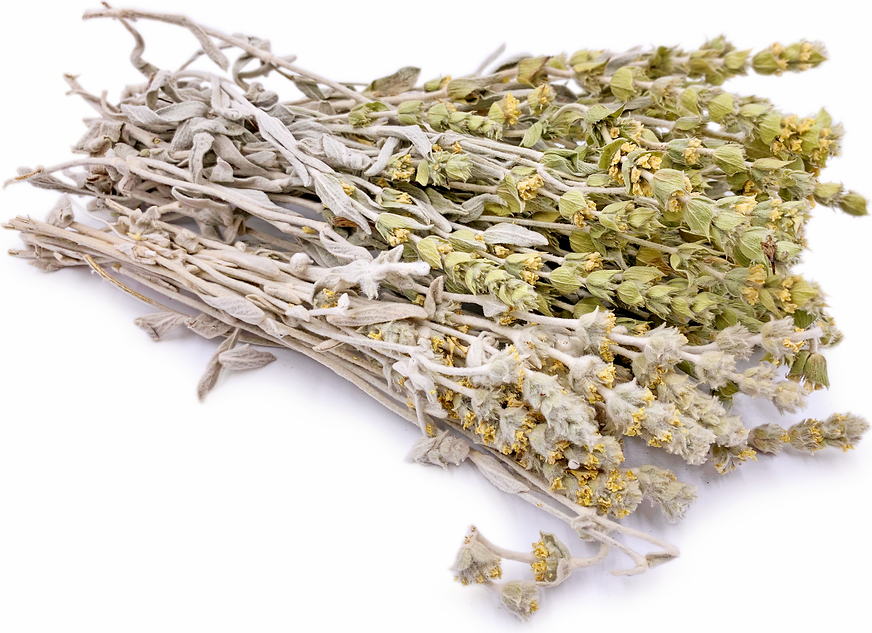


Mountain Tea
Estimated Inventory, lb : 0
Description/Taste
Mountain Tea is a low-growing plant that consists of short leaves and many small flowers attached to long, slender stems. The leaves and stems are silvery green with a velvet-like, fuzzy texture and the leaves are lanceolate to oval in shape. There are also smaller leaves covering the base of the flowers, known as bracts, that are green with pointed tips. The flowers grow vertically along the stems and are pale yellow, aromatic, and compact. The entire plant is edible, including the flowers, stems, and leaves, and it can be used both fresh and dried in teas. Mountain Tea has a mild, sweet, earthy, and floral flavor reminiscent of a blend of mint, chamomile, and citrus.
Seasons/Availability
Fresh Mountain Tea is harvested in the summer, and the dried version is available year-round.
Current Facts
Mountain Tea is a perennial herb that grows between 15-40 centimeters in height and belongs to the genus Sideritis, botanically a part of the Lamiaceae or mint family. Growing wild along rocky mountainsides of Southern Europe at elevations over nine-hundred meters, Mountain Tea is harvested by hand and has been used as a traditional herbal remedy since ancient times. Also known as Ironwort, Shepherd’s Tea, Tea of the Gods, Tea of the Titans, Tsai Tou Vou Nou, Tea of the Mountain, Malotira, Olympos Tea, and Parnassos Tea, there are over seventeen different varieties of Mountain Tea that are commonly harvested from the wild and Sideritis raeseri is the only variety also to be cultivated on a small scale. Favored for its earthy, sweet flavor and high nutritional properties, Mountain Tea is predominately used in tea, and the leaves, flowers, and stems can be used fresh or dried to brew the medicinal infusion.
Nutritional Value
Mountain Tea is an excellent source of iron, vitamin C, antioxidants, and essential oils.
Applications
Mountain Tea can be utilized fresh but is most commonly dried and used to make an herbal tea. The dried leaves, flowers, and stems can be sold whole in bunches, tied together with a string, or it can be lightly crushed, packaged, and sold as a loose-leaf tea. Once brewed, the caffeine-free tea has a very mild flavor that pairs well with honey, lavender, lemon, cinnamon, and chamomile. When harvested fresh, the leaves and stems should be used immediately for best flavor, and when dried, Mountain Tea can last 1-3 years when kept in a cool, dry, and dark place.
Ethnic/Cultural Info
In Greece, Mountain Tea has a long history of medicinal use and is known by many different local names according to the region and mountain it is grown on. The word Sideritis, which is the genus of the herb, translates to iron in Greek and is believed to have been derived from the plant’s similarity in shape to a spear and its ability to help heal wounds from iron weapons during the middle ages. Mountain Tea is also known as Shepherd’s Tea as Shepherds would often brew the herb into tea while watching over their animals in the mountains. In modern day, Mountain Tea is deeply rooted in oral tradition, and many locals are taught by their grandmothers to use the tea as a daily remedy for colds, flu, congestion, anxiety, overall well-being, and as a natural immunity booster.
Geography/History
Mountain Tea is native to Southern Europe and has been growing wild since ancient times. The herb grows in little to no soil along rocky slopes in warm, dry climates and is found at very high elevations, but it is also cultivated on a small scale for commercial use and grown in backyard gardens as a natural home remedy. Today Mountain Tea is found growing wild in Greece, Albania, Spain, Turkey, Bulgaria, Macedonia, and Kosovo. When made into a tea, it can be found at pharmacies, herbal stores, and grocery stores in Europe and is also sold online for sales in North America, Asia, South America, and Australia.
Recipe Ideas
Recipes that include Mountain Tea. One
| Lemon & Olives |
|
Greek Mountain Tea |




